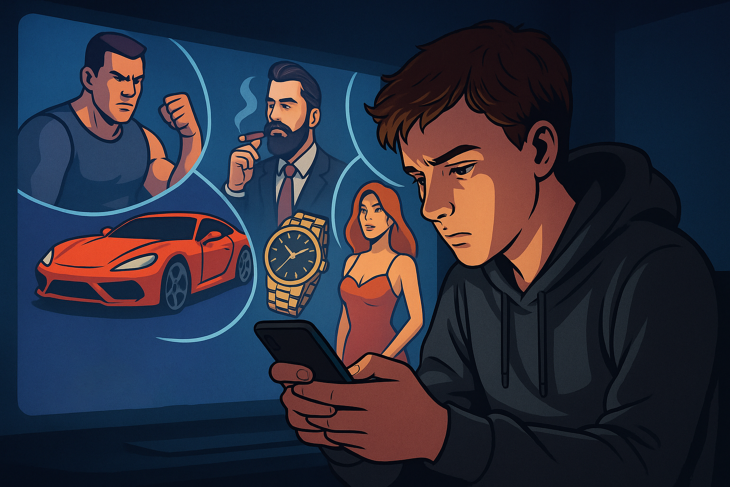The term 'manosphere' refers to a network of online communities where men express their frustrations, often about women, feminism, or broader societal changes. The manosphere takes many forms: from so-called ‘red pillers’ who claim men are being oppressed, to ‘incels’ (involuntary celibates) who blame women for their isolation. But the influence of the manosphere extends far beyond the internet. Its ideas seep into young people’s daily lives, shaping their self-image and their understanding of relationships.
The power of algorithms over young people
Why is the manosphere so appealing to young people? Part of the answer lies in the power of algorithms. Young people spend a significant amount of their time on social media, sharing experiences, making new friends, and strengthening existing relationships. Platforms like TikTok and Instagram play a particularly central role. These platforms run on algorithms that track every click, measure how long you watch a video, and analyse what catches your interest. Based on this data, they serve you more of the same kind of content.
That can be positive, helping you discover new hobbies, learn a language, or find inspiration. But there's a downside. Young users can become trapped in a stream of one-sided information, increasingly extreme views, or distorted representations of reality.
In recent years, social media platforms have come under fire for fuelling polarisation. Some have responded by working to reduce these effects. According to Dr Roel Lutkenhaus, Assistant Professor of Media and Communication at the University of Twente, certain platforms are collaborating with academic institutions to create safer digital spaces. “YouTube is leading the way here, especially with the development of the algorithm behind YouTube Kids,” says Lutkenhaus. “That algorithm has been redesigned to guide children towards educational and socially positive content. There’s still room for improvement, but it's a big contrast with companies like Meta, which are less open to such changes.”
Why do these algorithms work the way they do? Because social media platforms are profit-driven. Their goal is to keep users online as long as possible to maximise ad revenue. That, in itself, is not inherently wron, businesses are allowed to make a profit, as long as they follow the law. The real issue is that there are too few platforms that prioritise public values like education, connection, or wellbeing over commercial gain.
Lutkenhaus emphasises that algorithms are more than just recommendation engines. “They act as a mirror of our behaviour, reflecting human vulnerabilities like a hunger for drama or feelings of insecurity,” he explains. In other words, young people are often shown content that intensifies their fears or doubts, not because the platform wants to harm them, but because that’s what keeps them watching.
The appeal of being seen and understood
But algorithms aren't the only reason the manosphere appeals to young people. Group dynamics also play a powerful role. Within these online communities, young people find like-minded individuals, others who share the same frustrations and insecurities. This creates a sense of recognition and belonging, something many young people deeply long for. The danger is that it can also lead to the reinforcement of harmful ideas, without space for alternative views or critical reflection.
Dr Ruud Jacobs, Assistant Professor of Communication and Technology at the University of Twente, explains that the manosphere resonates with youth because it offers a simple, recognisable narrative. “It’s a story where men are portrayed as victims and women as the cause,” Jacobs says. “It taps into a sense of injustice that gets magnified.”
The consequences can be far-reaching. Young people may develop a distorted self-image, lose trust in relationships, or even adopt hostile attitudes toward others. The manosphere doesn’t just present a narrative, it offers a sense of community: a space where they feel understood, and where their anger or frustration is fuelled and validated.
Learning to think critically about content
But the manosphere isn’t something you can simply ban or ignore. It’s a symptom of broader societal uncertainties, questions around masculinity, shifting gender roles, and feelings of injustice. Rather than shielding young people from this kind of content, we need to empower them. And that starts with awareness. Understanding how these systems work is the first step. The next is learning to view content critically and recognising how it plays on your emotions.
Parents, schools, and policymakers all have an important role to play. By teaching young people to think critically, to ask questions, and to seek context, we can help them resist being swept up by extreme narratives. Media literacy needs to go beyond knowing how to use a smartphone, it must include the ability to understand how media shape your view of the world.
Understanding the manosphere is not only about protecting young people. It’s also a lens through which we can explore deeper societal issues: What does it mean to be a man in today’s world? Why are some young people drawn to extreme ideas? And how can we, as a society, have a constructive conversation about gender and identity?




